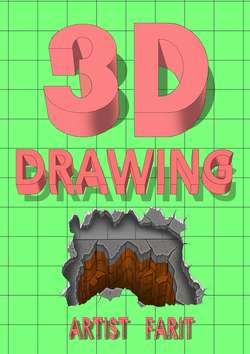Читать книгу 3D drawing. Tutorial 3D drawing - Artist Farit - Страница 7
Errors in 3D drawing
Next example
ОглавлениеMany may say that this cube is drawn correctly. In my humble opinion, this cube is drawn from a photograph. The horizon of the photograph on which this cube was drawn is much lower than the horizon of the platform on which this drawing is drawn. Therefore, I get the impression that the cube is very distorted. In my humble opinion, a preliminary photograph of this cube was taken from a lower point, and from a closer distance than the viewer looks at this picture. Therefore, the top face of the cube, I see not parallel to the floor surface. In my opinion, the top face of the cube is strongly inclined from the viewer.
To prove my point, a rectangular tile on the floor in this room helps me. We continue the seams of the rectangular tiles, and find the horizon of this site.
Now we find the horizon of the original photograph of the cube from which this drawing was made. The horizon of the cube (parallelepiped) can be found by continuing the horizontal sides of the cube if these sides are on the surface of the site or parallel to the surface of the site. Continue the horizontal sides of the cube until they intersect with each other. The continuation of the horizontal sides of the cube intersects at the horizon line of the photograph with which the cube was drawn. As you can see the horizon of the site and the horizon of the photo of the cube do much not coincide.
The top picture is the original.
In the bottom picture.
The cube is drawn so that its horizon coincides with the horizon of the site. In this case, the top face of the cube looks parallel to the floor surface of the room. Something like this should look like a cube drawn according to the laws of perspective (geometry), and not according to a photograph. Try to quickly look from the top picture to the bottom picture. Distortion of perspective becomes apparent. In any case, I can see.
The top picture is the original.
In the bottom picture.
The original cube is left, but a new area is drawn with the horizon matching the horizon of the cube. This is what the photograph used to draw this cube looked like.
There remains one POSSIBLE “mistake” – the mismatch between the distance from which the cube was photographed and the distance from which the viewer looks at the picture. That is why I have the impression that the near corner of the base of the cube is not straight, but sharp. Such a “mistake” can be obtained because the cube was photographed from a closer distance than the viewer looks at the drawing of the cube.
This possible “mistake” could be easily verified if the seams of the rectangular tile were parallel to one of the sides of the base of the cube. But in this figure, the seams of the tile are not parallel to the sides of the base of the cube, and it is not possible to check this possible error. Also, this possible “mistake” could be checked if the plates on the floor were square, but the plates on the floor of this room were not square, but rectangular.
How to draw a cube and the shadow of a cube correctly will be described and illustrated in detail in of this course. Or in one of the lessons on my Patreon page.
https://www.patreon.com/ArtistFarit
In the chapter or exercise “Parallelepipeds.”
